|
Natural Hoof TrimmingNatural hoof trimming is like packing a box. If you really want to protect the contents, you pack the box tightly. When packed well, the contents and container support each other. Leave a void inside the box and the fragile contents may move too much and break or the box will actually collapse from outside forces. Get the hoof wall and sole to grow tight around the coffin bone and you create a very protective container. The digital cushion and lateral cartilages, in the back of the hoof, pad and protect the sensitive structures deep inside the foot. A properly formed, naturally trimmed hoof, is strong and rigid in the front and supportive and well padded in the back. Guess what is in the middle benefitting from all this protection? The navicular bone and deep digital flexor tendon. Natural trimming is all about getting the package right. Environment MattersLet me start out by saying that my experience and interpretation of natural hoof trimming is strongly influenced by the environment where I work and the type of horses I work on. I live in northern Virginia. It is relatively wet here. The ground varies tremendously. Some areas are really soft and marshy and others are hard and rocky. I also trim in the coastal area of Virginia. Once again, it is moist. I trim a large variety of horses, but in this area, Thoroughbreds, Thoroughbred crosses and draft crosses are predominant. The feet on these horses want to flatten out and flare. Contracted feet are not the norm in my client base. Because of the moisture and the tremendous number of soft footed horses that I trim, I spend a lot time collecting the feet. Much of the information will seem foreign to you if you live in a more arid part of the world and have strong footed horses. What is inside the hoof capsule?
The other structures are soft and flexible. They consist of the deep digital flexor tendon, small ligaments, a fat pad called the digital cushion, and the lateral cartilages. The bars, frog and heel bulbs are built around the lateral cartilages and digital cushion. The lateral cartilage and digital cushion are the padding. In a healthy natural hoof, the coffin bone sits at the very front of the hoof. When the wall is in line with the coffin bone, there is a good lamilar connection. The pictures at the bottom of this page will make this point more clear.
Think of the lamina as velcro. If the wall and coffin bone are close and the lamina are healthy, then the two will be strongly stuck together. If the lamina are being pulled (leverage on the walls) or the lamina are not sticky any longer (swelling from laminitis), then the wall and coffin bone pull away from each other. This isn't good. Check out my anatomy page. It has good pictures showing the lamina and sole papillae.
Natural hoof trimming promotes strong lamilar connection.Natural hoof trimming minimizes the pull on the walls with a good mustang roll or bevel. This encourages the walls and sole to share the load bearing responsibilities of the hoof. The whole structure is stronger. Now lets think of the back of the foot. The lamina (velcro) extends all the way around the hoof and even on the bars. We don't want the velcro (lamina) pulled back here either, so the mustang roll works everywhere there is hoof wall. When the walls, coffin bone and sole are well connected encourages a tighter lamina connection between the coffin bone and walls. The coffin bone is the anchor in the front two thirds of the hoof. Its close proximity to the hoof wall is imperative. A close, well-balanced connection between the wall and coffin bone creates a supportive structure for the rest of the horse. The hooves affect muscles, tendons and ligaments all the way up the leg and throughout the body. Poor hoof function is very hard on the whole horse. Natural Hoof Trimming is a process.Remember achieving proper hoof shape is a process. It is hard on the horse if we take a distorted hoof and make radical changes. Ask the foot to change, don’t insist. I try to prioritize. What is the biggest weakness in the hoof? I work that first. I trim for strength and a reasonable amount of flexibility. I am convinced that rounded edges are the key to strength and plasticity. A good mustang roll is the best friend of natural hoof trimming. If you are looking for natural hoof trimming instruction, this is the first of many pages showing how I trim hooves. I am hoping that if you understand the logic behind the process, you will be better able to trim or assess your horses’ hooves. Where do I begin?
First ImpressionMy initial assessment gives me direction. It starts me thinking. This is where I trust my gut feelings. Each of the following descriptions gives me clues on which part of the hoof may be over used or underused or whether the horse looks healthy.
BalanceI have my own method of looking at balance. Natural hoof trimming is a process. I trim with balance in mind, but feel that it is prudent to have patience. Balance is acquired over time and if it isn't, then there is a reason.
Visualize the Coffin BoneThe hoof capsule offers clues that tell me where the coffin bone is within the hoof capsule. It is hard to teach this on one page of a website. I need to dedicate a whole page to this one topic. Below I have a few examples. I have drawn in where I think the coffin bone may be. If all my clients had current X-ray done on their horses hooves, this step would be much easier. So, instead, I have to take a stab at where I think it is. Even as a professional, all I am doing is making an educated guess. I have to constantly remind myself that trimming is a process.
PrioritizeI think of all the steps to natural hoof trimming, learning to prioritize what needs trimming first is the most important. I need a game plan. There are many priorities such as:
Sometimes the priority isn't about the hoof; it's about the horse. These last questions tell me that the horse may be laminitic, insulin resistant, possibly has ulcers, or has other health issues. Experience has taught me that I can work on correcting one section of the hoof at a time. As long as I do not over trim the whole hoof, then the area of greatest concern can be adjusted more radically. Keep this area to a minimum! For example, between 10:00 and 2:00 at the toe or it may be at the heel or even on the side of the hoof. I pick the part that is screaming at me. I don't do this on every horse or with every hoof.
Some ExamplesBelow are some examples of feet I see. Natural Hoof Trimming: Hoof 1A Healthy Hoof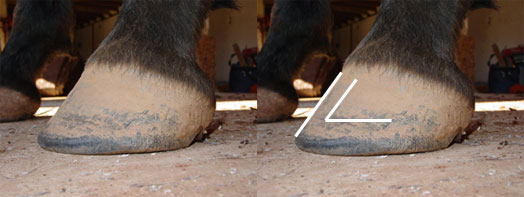
First Impression The first impression I get is that this horse is healthy and this hoof is healthy. Nothing jumps out at me. This hoof might or might not need to be trimmed. This will depend on if the owner can trim or if it is going to be a few weeks before I see the horse again. If you look at the page on trimming schedules you will see that there is a difference between owner trims and professional trims. Hoof Balance I covered balance extensively on this page.. Coffin Bone Placement I think the coffin bone and hoof wall are in close alignment. Priority for Trimming I would just refresh the mustang roll.
Natural Hoof Trimming: Hoof 2Long Toe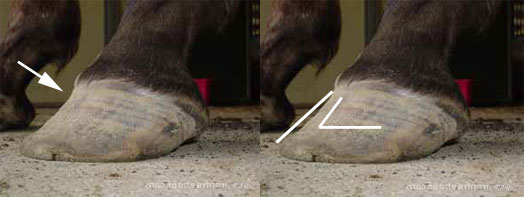
First Impression This foot looks weak. The toe has run forward. The hoof doesn't have very thick or healthy walls. Hoof Balance Didn't include the photo that shows this. Coffin Bone Placement I have pointed out that the wall isn't completely straight. It is steeper at the very top. My educated guess is that the coffin bone and hoof wall are not strongly attached. The long toe has created a lot of leverage on the hoof wall. Priority for Trimming I would work this toe back. I would be careful to not over trim the rest of the foot, but would not be shy bringing this toe back from 11:00 to 1:00 or possibly 10:00 to 2:00. I refer to the face of a clock when I trim.
Natural Hoof Trimming: Hoof 3Overgrown Hoof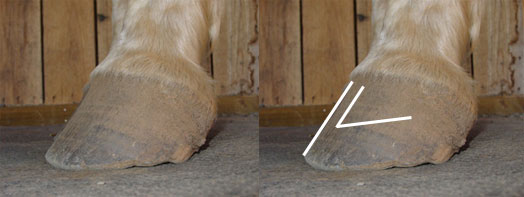
First Impression It looks like this hoof has thick, strong walls, and they look very long. This hoof is overgrown. This foot looks really tall all the way around. Coffin Bone Placement I am pretty sure the coffin bone and hoof wall are aligned pretty well. The heels may be a little high, causing the coffin bone to point down a little. Priority for Trimming I would evenly shorten the walls all the way around with a good mustang roll. I may spend a little extra time and energy addressing the heels and make sure the toe wasn't left too long.
Natural Hoof Trimming: Hoof 4High Heels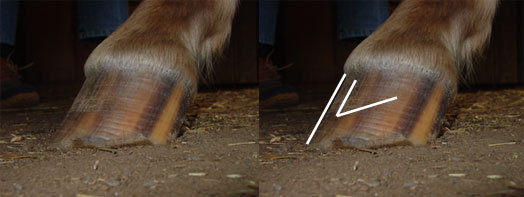
First Impression If you thought the previous hoof had high heels, then you will be even more alarmed by this hoof. This foot is long overall, but the heels are particularly high. Look at the coronary band, it is nearly flat and slopes down only marginally. Coffin Bone Placement Because the heels are so high, the coffin bone is tilted down. It still looks like the coffin bone and hoof wall are well connected. This could change easily if the lamina were weakened by laminitis (velcro got less sticky). Priority for Trimming It is very important to lower the heels and make sure the toe is shortened. If I only lowered the heels, then there would be a lot of leverage left at the toe.
Natural Hoof Trimming: Hoof 5Possible Negative Plane Coffin Bone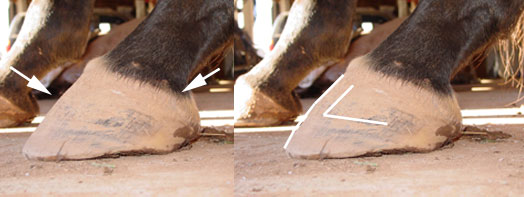
First Impression This hoof is a little more complicated than the previous hooves. My first impression is that the walls are thin. I don't like how the toe bows in the middle and how the coronary band is relatively straight and then dips where the arrow is. Coffin Bone Placement I think the coffin bone is higher at the front than the back. This is called a "negative plane" coffin bone. I feel even more sure of this coffin bone placement if there is an abnormal amount of concavity in front of the frog. Priority for Trimming A hoof like this generally has a reduced amount of digital cushion and thin lateral cartilages, so there isn't much heel to build up. It is very important to bring this toe back with a strong mustang roll. Shortening the toe will help take the pressure off the heels. This is an important step in helping this hoof.
Natural Hoof Trimming: Hoof 6Guessing Game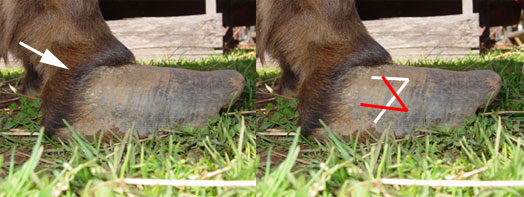
First Impression What do I do?!?!?! I put this picture up to show you that sometimes you may not know what you are dealing with. Coffin Bone Placement I honestly did not have any idea which direction the coffin bone was pointing. The coronary band was almost vertical, but the pastern angle still looked relatively normal. I knew the coffin bone was either oriented to the hoof wall (white lines) or somewhat normally (red lines). Or it was somewhere in between. I did not think it was pointing down. The sole was actually still concave. Priority for Trimming I knew I had to radically shorten this foot. I roughed in a more normal hoof shape and had to leave it at that. This foot was definitely a process!!! My version of natural hoof trimming is trying to obtain a healthier hoof shape. By healthier, I don't necessarily mean prettier or fitting certain parameters. For me, understanding anatomy and trusting the horse has led to more successful natural hoof trimming. I have learned to accept that trimming is a process and that I am only making an educated guess every time I trim the horse. The horse is my partner and is more knowledgeable than any professional or well meaning person. I have to trust his opinion.
Return from Natural Hoof Trimming to Iron Free Hoof Homepage |
